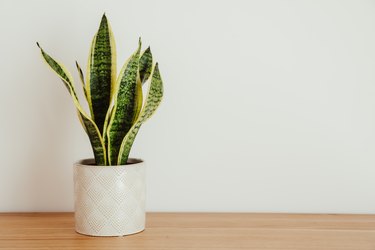
Snake plants, also called mother-in-law's tongue, are slow-growing, drought-tolerant plants that can thrive in almost any condition. Plant experts often claim snake plants "thrive on neglect." But like all houseplants, snake plants can have problems, no matter how hard you try to keep them alive. If you notice that yours looks wilted, discolored, or otherwise worse for wear, you may be experiencing one of these common snake plant problems.
1. Overwatering
Video of the Day
Snake plants have thick, wavy leaves that stand upright in variegated masses and lose water slowly, meaning they don't require frequent replenishing. Overwatering is a common mistake made by well-intentioned houseplant owners that can cause oxygen deprivation and root rot.
Video of the Day
If you have overwatered your snake plant, the first step is to pour off any water standing in the top of the container and in the drainage dish. Allow the plant to dry out until at least half of the potting medium is dry. Don't let the soil get so dry it separates from the container, however. If symptoms like yellowing leaves and wilting improve, you can resume a normal watering schedule. Water thoroughly, empty any water standing in the drainage dish after an hour or so and water again when the top 2 inches of the soil are dry.
2. Stress
Your snake plant may become stressed or in shock if it's exposed to too much sunlight, if you over or underwater it, or if you repot it under stressful conditions (like major temperature differences). The fix to this problem is relatively simple — change its environment. Snake plants thrive in indirect sunlight, so if yours sits on your sun-filled kitchen window, it's time to move it. If your snake plant is getting too big for its container and you need to repot it, try to repot only in the late winter or spring. Repotting in this time period minimizes stress because the plant is in dormancy for the winter and has not yet begun active growing, which occurs in the spring.
3. Root Rot
Your snake plant may have root rot if it's wilted and discolored. Check the roots by gently lifting the plant out of its container. If half to all of the roots are brown and mushy, just discard the plant. It is too far gone to save. Otherwise, use clean scissors and cut the roots off above the brown, mushy sections. Leave as much of the healthy root intact as possible. Repot the plant in a new pot with a drainage dish. Use new potting medium at a mixture of three parts peat to one part potting soil. Water thoroughly, discard any water left in the drainage dish after about an hour and only water again when the top 2 inches of soil are dry.
4. The Wrong Pot
Containers are an important part of houseplant irrigation. A container without drainage holes not only allows water to sit in the pot, but it prevents salts and other potentially harmful minerals from being flushed out. Drainage holes are critical for a healthy snake plant. The material a pot is made from is also important. Plastic pots or glazed ceramic pots retain moisture longer than unglazed ceramic pots do. Plants sensitive to over watering may fare better in a ceramic pot than a plastic pot.